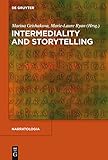Intermediality and Storytelling / ed. by Marina Grishakova, Marie-Laure Ryan.
Material type: TextSeries: Narratologia : Contributions to Narrative Theory ; 24Publisher: Berlin ; Boston : De Gruyter, [2010]Copyright date: ©2011Description: 1 online resource (353 p.) : 13 Abb. 4c zusätzlichContent type:
TextSeries: Narratologia : Contributions to Narrative Theory ; 24Publisher: Berlin ; Boston : De Gruyter, [2010]Copyright date: ©2011Description: 1 online resource (353 p.) : 13 Abb. 4c zusätzlichContent type: - 9783110237733
- 9783110237740
- 302.23 22
- P96.N35 I67 2010eb
- online - DeGruyter
- Issued also in print.
| Item type | Current library | Call number | URL | Status | Notes | Barcode | |
|---|---|---|---|---|---|---|---|
 eBook
eBook
|
Biblioteca "Angelicum" Pont. Univ. S.Tommaso d'Aquino Nuvola online | online - DeGruyter (Browse shelf(Opens below)) | Online access | Not for loan (Accesso limitato) | Accesso per gli utenti autorizzati / Access for authorized users | (dgr)9783110237740 |
Browsing Biblioteca "Angelicum" Pont. Univ. S.Tommaso d'Aquino shelves, Shelving location: Nuvola online Close shelf browser (Hides shelf browser)
Frontmatter -- Contents -- Editors’ preface -- Fiction, Cognition, and Non-Verbal Media -- Narrativity and Segmentivity, or, Poetry in the Gutter -- Vulgar Metaphysicians: William S. Burroughs, Alan Moore, Art Spiegelman, and the Medium of the Book -- Previously On: Prime Time Serials and the Mechanics of Memory -- The Paranoid Style in Narrative: The Anxiety of Storytelling After 9/11 -- Inter-Action Movies: Multi-Protagonist Films and Relationism -- All Talking! All Singing! All Dancing! Prolegomena: On Film Musicals and Narrative -- Photo Narrative, Sequential Photography, Photonovels -- The Failure of Art: Problems of Verbal and Visual Representation in Let Us Now Praise Famous Men -- Interactivity and Interaction: Text and Talk in Online Communities -- Games of Interpretation and a Graphophiliac God of War -- Advertising the Medium: On the Narrative Worlds of a Multimedia Promotional Campaign for a Public Service Television Channel -- The Narrative Worlds and Multimodal Figures of House of Leaves: “— find your own words; I have no more” -- Intermedial Metarepresentations -- Backmatter
restricted access online access with authorization star
http://purl.org/coar/access_right/c_16ec
The ‘narrative turn’ in the humanities, which expanded the study of narrative to various disciplines, has found a correlate in the ‘medial turn’ in narratology. Long restricted to language-based literary fiction, narratology has found new life in the recognition that storytelling can take place in a variety of media, and often combines signs belonging to different semiotic categories: visual, auditory, linguistic and perhaps even tactile. The essays gathered in this volume apply the newly gained awareness of the expressive power of media to particular texts, demonstrating the productivity of a medium-aware analysis. Through the examination of a wide variety of different media, ranging from widely studied, such as literature and film, to new, neglected, or non-standard ones, such as graphic novels, photography, television, musicals, computer games and advertising, they address some of the most fundamental questions raised by the medial turn in narratology: how can narrative meaning be created in media other than language; how do different types of signs collaborate with each other in so-called ‘multi-modal works’, and what new forms of narrativity are made possible by the emergence of digital media.
Issued also in print.
Mode of access: Internet via World Wide Web.
In English.
Description based on online resource; title from PDF title page (publisher's Web site, viewed 28. Feb 2023)









